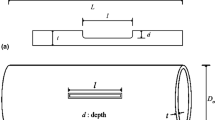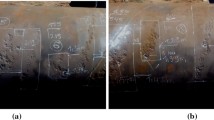Abstract
Pipelines are identified as one of the most important elements in the transmission of energy worldwide, and hence, their maintenance is of great importance. Accordingly, many standards have been developed to maintain these pipelines in services, such as ASME B31G and ASME PCC2. In recent years, composite patches are increasingly utilized to repair damaged areas Therefore, there are many studies carried out on this repair system. However, the behavior of the patches and repaired pipes has rarely been studied under dynamic pressures and water hammer phenomenon conditions. The main objective of this paper is to study the effect of the water hammer phenomenon on the damaged area of the steel pipe. Moreover, the behavior of the composite patch, which was used for repairing, after the passage of the pressure wave is studied. Furthermore, the effect of strain rates on composite patch damage is investigated by a specific VUMAT subroutine in the numerical model. It was found that despite the good resistance of the steel pipe in the damaged area, the composite patch is very vulnerable and fails after the water hammer shock wave. Therefore, it is recommended that for all pipelines where there is a risk of water hammer impact, repaired patches, based on ASME PCC2, should be re-examined and restored.

















Similar content being viewed by others
References
J.M. Duella, J.M. Wilsona, M.R. Kessler, Analysis of a carbon composite overwrap pipeline repair system. Int. J. Press. Vessels Pip. 85(11), 782–788 (2008)
M.W.D. JellisonTravisEllison, Moisture effects on the thermal and creep performance of carbon fiber/epoxy composites for structural pipeline repair. Compos. B Eng. 45(1), 1173–1180 (2013)
L. Mazurkiewicza, Experimental and numerical study of steel pipe with part-wall defect reinforced with fibre glass sleeve. Int. J. Press. Vessels Pip. 149, 108–119 (2017)
B.C. Mondal, Finite-element evaluation of burst pressure models for corroded pipelines. J. Press. Vessel Technol. 139, 021704-1 (2017)
H. Hooputra, A comprehensive failure model for crashworthiness simulation of aluminium extrusions. Int. J. Crashworthiness 9, 449–464 (2004)
V.A.A.M. Hovdelien, Impact Against Offshore Pipelines. Master thesis, Norwegian University of Science and Technology (2012)
E.B. Wylie, V.L. Streeter and L. Suo, Fluid Transients in Systems, Englewood Cliffs, New Jersey, USA 5. Froehlich, K.-P.; DDR-Wirt schafts patent Nr.: DD-PS 201041/4: PrenticeHall Inc (1993)
D. Covas, Water hammer in pressurized polyethylene pipes: conceptual model and experimental analysis. Urban Water J. 1, 177–197 (2004)
C. Cheng, Dynamic burst pressure simulation of cylindrical shells. J. Press. Vessel Technol. (2009)
“American Society of Mechanical Engineers, 1991, Manual for Determining the Remaining Strength of Corroded Pipelines, ASME B31G-1991, New York”
“The American Society of Mechanical Engineers ASME PCC-2–2015 Repair of Pressure Equipment and Piping”
C.-K. Oh, Ductile failure analysis of API X65 pipes with notch-type defects using a local fracture criterion. Int. J. Press. Vessels Pip. 84, 512–525 (2007)
Z. Marioli-Riga, D. Xenos, C. Vrettos, A standard analysis methodology for the stress analysis of repaired aircraft structures with the method of composite patch repair. Appl. Compos. Mater. 11, 191–203 (2004)
B.A.M.B. Melve, Critical defects in adhesive tubular joints of GRP process pipes determined with acoustic emission, in Proceedings of Ninth International Conference on Composite Materials (ICCM/9), Madrid (1993)
N.A.Yahya, Effects of carbon fiber reinforced plastic laminate on the strength of adhesive joints. Int. J. Eng. Inf. Technol. IJEIT 4(1) (2017)
N.A. Yahya, The use of bilinear cohesive zone model to study the fracture of mode I in adhesive joints. Int. J. Eng. Inf. Technol. IJEIT 5(1) (2018)
A. Saffar, Prediction of failure pressure in pipelines with localized defects. J. Fail. Anal. Prev. 1–14 (2019)
I.M. Daniel, B.T. Werner, J.S. Fenner, Strain-rate-dependent failure criteria for composites. Compos. Sci. Technol. 71, 357–364 (2011)
E.U.M.V. Algirdas Kaliatka, Uncertainty and sensitivity analysis of water hammer phenomenon by employing the Umsicht test facility data, in The 11th International Topical Meeting on Nuclear Reactor Thermal-Hydraulics, Avignon, France (2005)
I.U. Toor, H.M. Irshad, H.M. Badr, M.A. Samad, The effect of impingement velocity and angle variation on the erosion corrosion performance of API 5L-X65 carbon steel in a flow loop. Metals 8, 402 (2018)
N.A. Abrosimov, Numerical simulation of the process of loss of stability of composite cylindrical shells under combined quasi-static and dynamic actions. Mech. Compos. Mater. 55, 41–52 (2019)
G.O. Widera, Dynamic burst pressure simulation of cylindrical shells. J. Press. Vessel Technol. (2009)
S. Matta, Progressive damage analysis of adhesively bonded patch repaired carbon fibre–reinforced polymer specimen under compression involving cohesive zone model. Int. J. Damage Mech 28(10), 1457–1489 (2019)
C. Zhang, Ballistic performance and damage simulation of fiber metal laminates under high-velocity oblique impact. Int. J. Damage Mech. (2020)
L. Cortese, Prediction of ductile failure in materials for onshore and offshore pipeline applications. Int. J. Damage Mech 23(1), 104–123 (2014)
R. Hojjati-Talemi, Finite element simulation of dynamic brittle fracture in pipeline steel: a XFEM-based cohesive zone approach. Proc. Inst. Mech. Eng. Part L 232(5), 357–370 (2016)
Hyun-Suk Nam, Numerical simulation and experimental validation of ductile tearing in A106 Gr. B piping system under simulated seismic loading conditions. Proc. Inst. Mech. Eng. Part L 233(1), 28–38 (2019)
Author information
Authors and Affiliations
Corresponding author
Additional information
Publisher's Note
Springer Nature remains neutral with regard to jurisdictional claims in published maps and institutional affiliations.
Rights and permissions
About this article
Cite this article
Saffar, A., Darvizeh, A., Ansari, R. et al. Studying the Effect of Water Hammer Shock Wave on Composite Repaired Patches Based on ASME PCC-2. J Fail. Anal. and Preven. 21, 570–581 (2021). https://doi.org/10.1007/s11668-020-01100-8
Received:
Revised:
Accepted:
Published:
Issue Date:
DOI: https://doi.org/10.1007/s11668-020-01100-8




